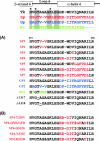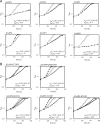Engineering of a type III rubisco from a hyperthermophilic archaeon in order to enhance catalytic performance in mesophilic host cells
- PMID: 17675435
- PMCID: PMC2075004
- DOI: 10.1128/AEM.00044-07
Engineering of a type III rubisco from a hyperthermophilic archaeon in order to enhance catalytic performance in mesophilic host cells
Abstract
The hyperthermophilic archaeon Thermococcus kodakaraensis harbors a type III ribulose 1,5-bisphosphate carboxylase/oxygenase (Rbc(Tk)). It has previously been shown that Rbc(Tk) is capable of supporting photoautotrophic and photoheterotrophic growth in a mesophilic host cell, Rhodopseudomonas palustris Delta3, whose three native Rubisco genes had been disrupted. Here, we have examined the enzymatic properties of Rbc(Tk) at 25 degrees C and have constructed mutant proteins in order to enhance its performance in mesophilic host cells. Initial sites for mutagenesis were selected by focusing on sequence differences in the loop 6 and alpha-helix 6 regions among Rbc(Tk) and the enzymes from spinach (mutant proteins SP1 to SP7), Galdieria partita (GP1 and GP2), and Rhodospirillum rubrum (RR1). Loop 6 of Rbc(Tk) is one residue longer than those found in the spinach and G. partita enzymes, and replacing Rbc(Tk) loop 6 with these regions led to dramatic decreases in activity. Six mutant enzymes retaining significant levels of Rubisco activity were selected, and their genes were introduced into R. palustris Delta3. Cells harboring mutant protein SP6 displayed a 31% increase in the specific growth rate under photoheterotrophic conditions compared to cells harboring wild-type Rbc(Tk). SP6 corresponds to a complete substitution of the original alpha-helix 6 of Rbc(Tk) with that of the spinach enzyme. Compared to wild-type Rbc(Tk), the purified SP6 mutant protein exhibited a 30% increase in turnover number (k(cat)) of the carboxylase activity and a 17% increase in the k(cat)/K(m) value. Based on these results, seven further mutant proteins were designed and examined. The results confirmed the importance of the length of loop 6 in Rbc(Tk) and also led to the identification of specific residue changes that resulted in an increase in the turnover number of Rbc(Tk) at ambient temperatures.
Figures



Similar articles
-
Phototrophic growth of a Rubisco-deficient mesophilic purple nonsulfur bacterium harboring a Type III Rubisco from a hyperthermophilic archaeon.J Biotechnol. 2006 Jul 25;124(3):532-44. doi: 10.1016/j.jbiotec.2006.02.001. Epub 2006 Mar 13. J Biotechnol. 2006. PMID: 16530868
-
Mutation design of a thermophilic Rubisco based on three-dimensional structure enhances its activity at ambient temperature.Proteins. 2016 Oct;84(10):1339-46. doi: 10.1002/prot.25080. Epub 2016 Jun 24. Proteins. 2016. PMID: 27273261
-
Structure-based catalytic optimization of a type III Rubisco from a hyperthermophile.J Biol Chem. 2010 Dec 10;285(50):39339-47. doi: 10.1074/jbc.M110.147587. Epub 2010 Oct 6. J Biol Chem. 2010. PMID: 20926376 Free PMC article.
-
The unique pentagonal structure of an archaeal Rubisco is essential for its high thermostability.J Biol Chem. 2002 Aug 30;277(35):31656-62. doi: 10.1074/jbc.M203117200. Epub 2002 Jun 17. J Biol Chem. 2002. PMID: 12070156
-
Catalyzing "hot" reactions: enzymes from hyperthermophilic Archaea.Chem Rec. 2002;2(3):149-63. doi: 10.1002/tcr.10023. Chem Rec. 2002. PMID: 12112867 Review.
Cited by
-
An overview of 25 years of research on Thermococcus kodakarensis, a genetically versatile model organism for archaeal research.Folia Microbiol (Praha). 2020 Feb;65(1):67-78. doi: 10.1007/s12223-019-00730-2. Epub 2019 Jul 8. Folia Microbiol (Praha). 2020. PMID: 31286382 Review.
-
Natural carbon fixation and advances in synthetic engineering for redesigning and creating new fixation pathways.J Adv Res. 2023 May;47:75-92. doi: 10.1016/j.jare.2022.07.011. Epub 2022 Jul 30. J Adv Res. 2023. PMID: 35918056 Free PMC article. Review.
-
An Insight of RuBisCO Evolution through a Multilevel Approach.Biomolecules. 2021 Nov 25;11(12):1761. doi: 10.3390/biom11121761. Biomolecules. 2021. PMID: 34944405 Free PMC article.
-
Selection of Cyanobacterial (Synechococcus sp. Strain PCC 6301) RubisCO Variants with Improved Functional Properties That Confer Enhanced CO2-Dependent Growth of Rhodobacter capsulatus, a Photosynthetic Bacterium.mBio. 2019 Jul 23;10(4):e01537-19. doi: 10.1128/mBio.01537-19. mBio. 2019. PMID: 31337726 Free PMC article.
-
Removal of phosphoglycolate in hyperthermophilic archaea.Proc Natl Acad Sci U S A. 2024 Apr 16;121(16):e2311390121. doi: 10.1073/pnas.2311390121. Epub 2024 Apr 9. Proc Natl Acad Sci U S A. 2024. PMID: 38593075 Free PMC article.
References
-
- Andrews, T. J., and G. H. Lorimer. 1987. Rubisco: structure, mechanisms, and prospects for improvement, p. 131-218. In M. D. Hatch and N. K. Boardman (ed.), The biochemistry of plants. Academic Press, San Diego, CA.
-
- Ezaki, S., N. Maeda, T. Kishimoto, H. Atomi, and T. Imanaka. 1999. Presence of a structurally novel type ribulose-bisphosphate carboxylase/oxygenase in the hyperthermophilic archaeon, Pyrococcus kodakaraensis KOD1. J. Biol. Chem. 274:5078-5082. - PubMed
-
- Fujii, T., A. Nakazawa, N. Sumi, H. Tani, A. Ando, and M. Yabuki. 1983. Utilization of alcohols by Rhodopseudomonas sp. no. 7 isolated from n-propanol-enrichment cultures. Agric. Biol. Chem. 47:2747-2753.
Publication types
MeSH terms
Substances
LinkOut - more resources
Full Text Sources
Miscellaneous

